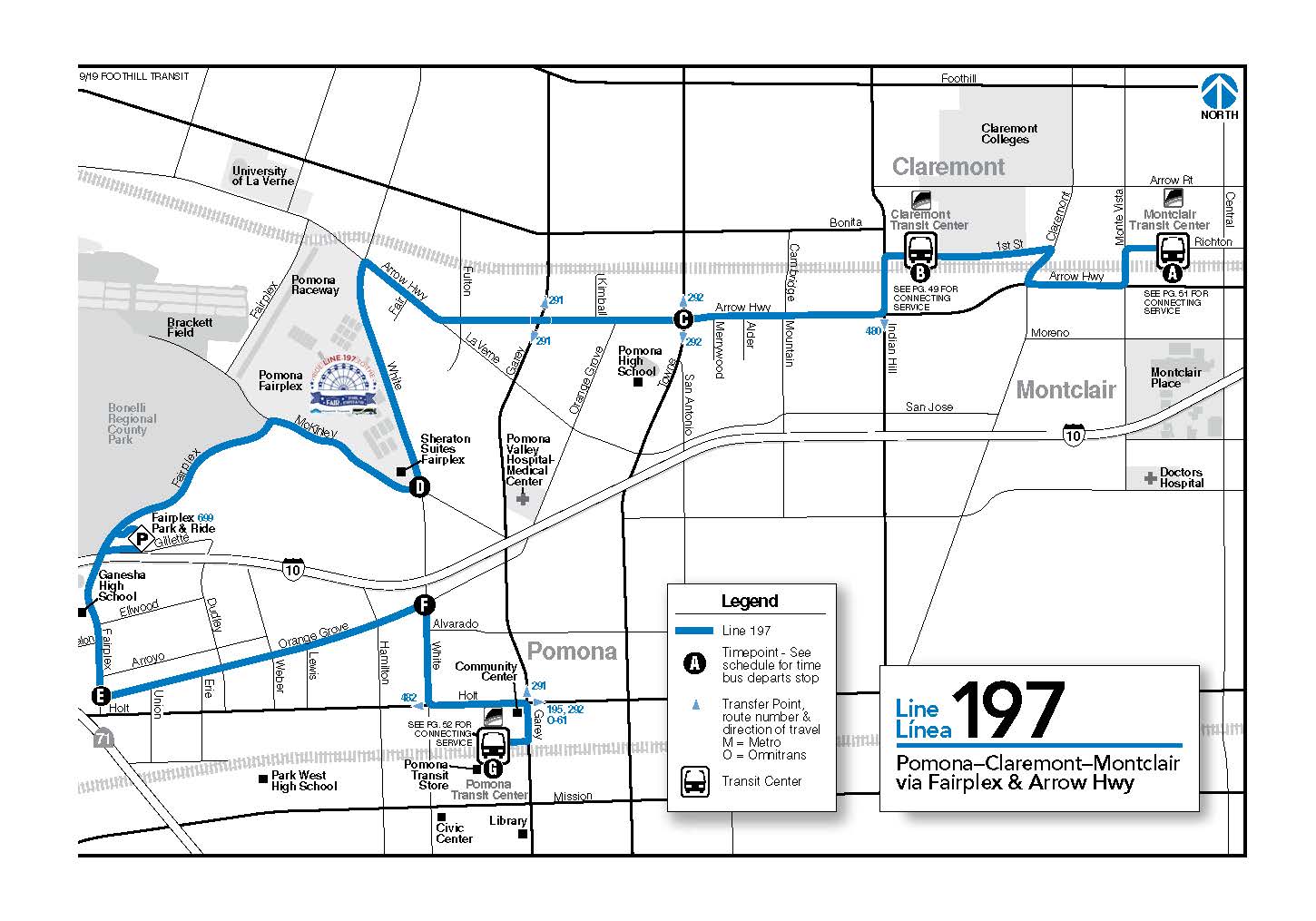Metro’s The Source Retreads Tired Pro-Freeway Falsehoods Today
5:35 PM PDT on May 25, 2022
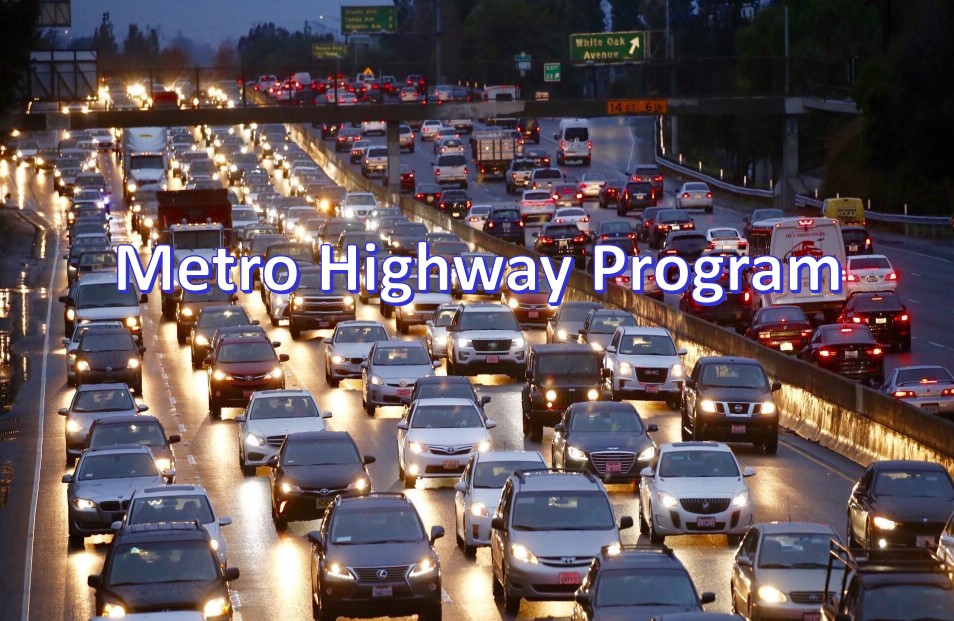
Metro Highway Program image via Metro presentation
Metro's communications team has kicked into high gear to churn out gaslighting spin pieces that attempt to paint a happy face on the agency's freeway-flush, transit-austerity proposed FY23 budget. Today's The Source post, "A closer look at highway spending in Metro’s proposed budget for fiscal year 2023," appears to be Metro's attempt to deflect criticisms raised by livability advocates, including Streets for All, Investing in Place, and the Alliance for Community Transit (ACT-LA).
The Source's timing does raise the question of why - after Metro's so-called "Early, Expanded, and Enhanced Public Engagement" in an "equity focused" "Listen and Learn" budget process (which many Metro staff repeatedly praise themselves about) - why is today the day to look closer at the $634 million Highway Program budget? Why now, just one day before the budget goes before the Metro board for an approval vote?
Why didn't The Source take a closer look at the Highway budget earlier - say, while the budget was still being developed? Perhaps in March, when Metro staff announced that the Highway budget was due to increase by thirty percent? It sure appears that Metro is following the outdated "decide, announce, and defend" model of public engagement here.
The Metro budget vote is due to take place at tomorrow's 10 a.m. board meeting, so Streetsblog will help out by clarifying the misleading and false statements in today's post at The Source.
From The Source:
How does funding for our highway program compare to our proposed spending on transit?
Metro’s proposed budget includes $2.3 billion for transit expansion, almost $2.2 billion for transit operations, $506 million for modernizing transit and keeping it in a state of good repair, about $1.9 billion in funding for cities and other transit agencies in L.A. County and $273 million for regional rail.
That comes to almost $7.2 billion for transit versus $634 million in funding for highway projects.
The Source rolls "funding for cities" into funding "for transit," but Metro's own figures show that cities spend the vast majority of Metro "local return" funds to support driving, with only four percent going to transit. For those unfamiliar with the "local return" program, several Metro sales tax measures include funding that Metro passes through to municipalities (mostly cities) to spend for transportation purposes. Cities spend these funds heavily on car-centric transportation.
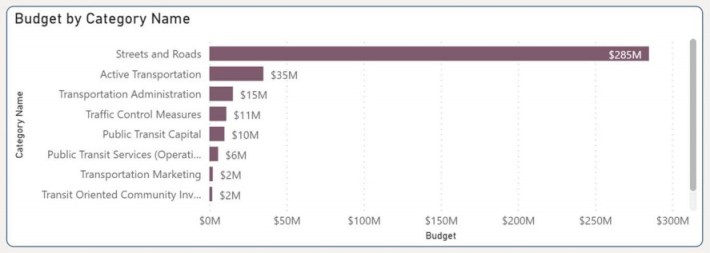
FY23 car-centered local city pass-through ($822 million) is a lot bigger than transit agency pass-through ($536 million). Lumping these together and calling it a "transit" component, which is much smaller, is misleading.
The main issue that Streetsblog has focused on is not the overall percentage of the Metro budget that is focused on highways compared to transit, but the alarming growth of the highway total in the past couple of years. At a time when Metro leadership professes to be concerned about equity and climate, somehow Metro is rapidly growing its freeway expansion program. In FY21, Metro's Highway Program was $264 million - 4.4 percent of the budget. This year, the proposed $634 million Highway Program budget is 7.2 percent of the budget.
The Source post goes on:
Does highway funding include money for transit improvements?
Yes. Complete street improvements on roads near freeways are part of most highway projects, and help make streets more hospitable, safer and more attractive to pedestrians and cyclists. The budget also includes $225 million in local street projects in cities across LA County, which include pedestrian and bike improvements.
Our Highway Program budget also supports the development of new bus lanes to speed up our bus system and make buses more reliable and less prone to getting stuck in traffic.
No. Metro's Highway Program budget does not foster improved transit, nor complete streets, nor streets that are more hospitable, safer, or more attractive to pedestrians and cyclists. Metro is widening freeways, ramps, roads, bridges, and intersections, which make for more and more car traffic, creating places that are more and more hostile to walking and bicycling. In some Metro highway projects, Metro and Caltrans are eliminating sidewalks - for example on the new Burbank Boulevard Bridge.
Two of the following paragraphs were corrected 5/31: Twitter user @numble has pointed out that, extrapolating from earlier approvals there may be a few bike/ped/complete streets projects in the FY23 Highway budget - potentially including relatively small expenditures for projects in East L.A., Long Beach, Burbank, and/or the South Bay. Streetsblog stands behind this post's broad assertion that it is misleading for Metro to repeatedly point out a small percentage of complete streets projects that are unrepresentative of the larger Highway budget focus on widening freeways/roads/ramps.
For many years, Metro Highway Program staff fought vigorously against including any complete streets components in "highway" projects, which include projects on local streets. This exclusion "policy" was officially changed in June 2021, less than a year ago. It takes time for projects to get through development/approval pipelines, and there are still no few, if any, complete streets projects in the FY23 Highway Program budget.
There are tiny bike/ped project components in the Highway budget; most of those are just re-doing existing sidewalks/bikeways as part of widening bridges - for cars - over widened freeways.
There are hardly any no complete streets projects, no bikeways, no or pedestrianization projects - none - in the FY23 Highway Program budget. Metro repeatedly claiming citing this unrepresentative sliver is gaslighting.
The last sentence (about bus lanes) here is misdirection. Yes, alongside more than $500 million (80+ percent of the budget) focused on widening freeways/ramps/roads, the Metro Highway budget has $11.1 million (1.8 percent) for bus lanes. Metro staff tout these bus lanes over and over, but they are a minuscule, unrepresentative portion of the Highway budget. (See also earlier SBLA debunkings of the tired "Metro freeway widening improves transit" myth.)
The Source then states:
Closing gaps in or expanding the HOV and ExpressLanes systems are essential to improving transit and ridesharing opportunities for commuters, carpoolers, vanpools, commuter buses and regional transit.
Here's that "Metro is widening freeways to improve transit" lie again. No HOV or ExpressLanes project is "essential" to transit. Most Metro freeway widening is in places where there are no buses on the freeways. And for the rare places where there is an occasional vanpool or (infrequent, thanks to the Metro budget) bus on the freeway, Metro is justifying massive expansions for a flood of drivers by pointing to a tiny trickle of buses.
The Source lists various freeway widenings - on the 57/60, the 5 in Burbank, the 5 in Santa Clarita, "modernizing" [widen by four-plus lanes] the 5 next to OC, and the 138 - claiming these "will reduce unnecessary weaving, delays, and idling that results in more air pollution." Widening freeways will reduce air pollution? Really? (Metro and Caltrans have made this claim over and over.)
Then The Source goes on to note:
Other highway projects include freeway operational and safety improvements on SR-91 and I-605, all done within existing freeway corridors — meaning there is no need relocations. [sic - probably intended to be "... no need for relocations"?]
It's puzzling why Metro picked its 91 and 605 freeway projects as supposed examples of "no relocation" projects.
Metro's 91 Freeway widening project [according to its own environmental study - see page 2.3-19] plans to demolish five homes on 168th Street in the city of Artesia - plus relocating a couple of businesses.
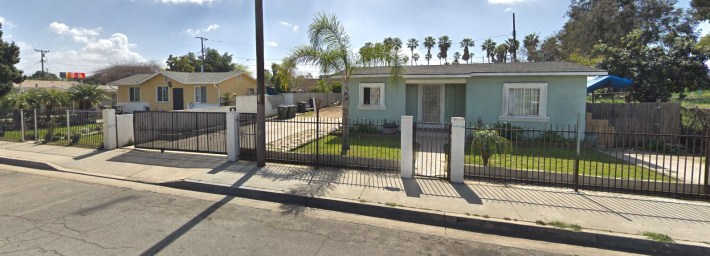
Metro's 605 Corridor Improvement Project is basically on hold because communities, cities, and even freeway builders opposed the project's impact on more than a thousand parcels, including demolishing hundreds of homes and apartment buildings.
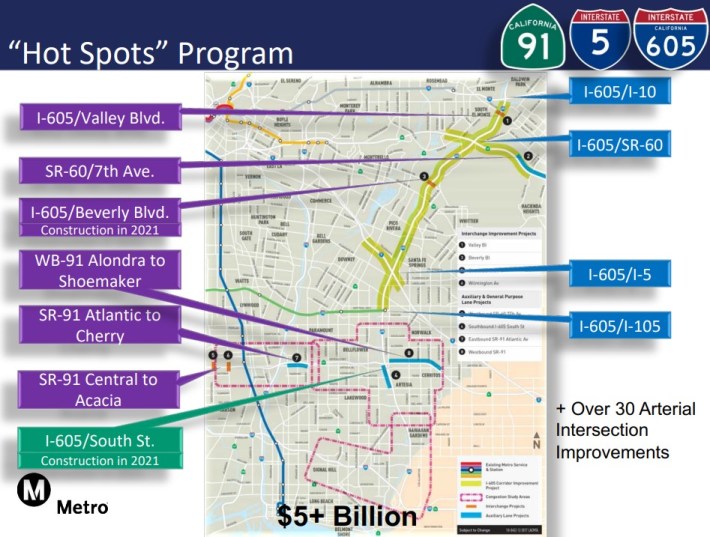
These are both part of Metro's 605 Freeway corridor "Hot Spot" improvements, which is mainly widening ramps/streets/intersections leading to the 605. Some the 605 hot spot widenings (including the "SR-60 / 7th Ave. Interchange") do impact adjacent parcels, hence, they do need relocations.
That "no relocations" projects somehow equate to a good thing is another Metro myth. Lots of Metro's freeway widenings demolish and/or harm adjacent homes, apartments, businesses, and an occasional park, school, public golf course, etc. So, Metro likes to cherry-pick a few selected freeway widening projects, and say these ones are okay because they don't demolish homes. This is an improvement over the past ~80 years of freeway construction erasure of Black and brown neighborhoods, but just having "no relocations" does not make a good project. Freeway widening invests public resources in projects that serve only those residents that have sufficient income to get around by car. Also, widening freeways means subjecting adjacent neighborhoods (like communities of color along the 91) to more car traffic and more pollution, and pumping more greenhouse gases into the warming climate.
Then The Source states:
Additionally, the Highway budget also includes funding ($20 million) for soundwall construction to help reduce noise in impacted and often disadvantaged communities.
More misdirection here by pointing to another minuscule component: the soundwall program is just three percent of the total Highway budget.
But: implying that the Metro Highway budget benefits disadvantaged communities? Freeway builders tore down "disadvantaged communities" for eighty-plus years. Now, Metro wants the public to support the Highway budget because it will provide battered communities palliative sound walls. Are sound walls the best Metro's highway builders can offer folks who suffer from asthma and are showered with harmful pollutants? Sound walls are perhaps a needed minimum. How about reparations? What about working with freeway-harmed communities to invest in solutions that center their health and well-being? Maybe foster equity by stepping up investments in pedestrian safety, transit, health clinics, air filtration for schools and homes, tree planting, etc. in disproportionately freeway-harmed areas? How about, as is being done in some parts of the country, tearing down some freeways to restore the neighborhoods, the affordable housing, the parks, and the rest that highway builders razed?
Then The Source tries to get a little real:
Do highway projects result in wider roads?
Most of our projects do add lanes. But we use a targeted approach so that most of our projects do not require property relocations.
For example, we add auxiliary (merging) lanes to the right side of freeways to help improve traffic flow and safety at old interchanges in which merging traffic and exiting traffic conflict. These improvements are necessary because most freeways in L.A. County were not built to handle today's traffic levels.
Even the way the question is worded here tries to deflect attention from Metro freeway widening. "Do highway projects result in wider roads?" makes it sound like wider roads are not the express purpose of Metro's Highway Program. Metro was trying to be helpful, but, oops, sorry, the roads somehow got wider. Widening is not just some "result" of a program dedicated to increasing car capacity. It's what Metro does. It's what Metro funds. It's what Metro builds. Does striking a match "result in" a flame? Yes, that's not just a result, it's why one strikes a match.
"Most of our projects do add lanes" is true, but putting it mildly. More than eighty percent of the Metro highway program is about widening freeways/ramps/streets.
(SBLA addressed the "property relocations" [demolitions] claim above. Recently, Metro's so-called "targeted approach" has resulted in hundreds of home demolitions along various stretches of the 5 and 71 Freeways. In 2018, Metro approved a lower 710 widening alternative that would have torn out hundreds of homes/businesses. In 2020 Metro announced plans to demolish hundreds of homes along the 5 and 605. Mercifully, thanks to community resistance, the 710 and 605/5 projects are essentially on hold.)
And then there's the auxiliary lane thing. Freeway builders love to say that "aux lanes" (general purpose car lanes that just extend between ramps) are not really widening, though they increase capacity and induce more driving.
Metro says that freeway widening is "necessary" because "most freeways in L.A. County were not built to handle today's traffic levels." Hey, Metro, L.A. County's transit, sidewalks, Access Services, and bikeways are also insufficient for today's population. Any chance those could be added to your budget's "necessary" list? Metro has allowed transit capacity to deteriorate (and this year, Metro is proposing to cut transit expansion construction by 8.3 percent), but somehow wider freeways are "necessary" and addressing languishing transit isn't.
And then The Source gives up:
But how will Metro get people out of cars if they keep funding roads?
We absolutely want to provide a wider menu of options to getting around so everyone isn’t so reliant on driving.
The stark reality is that L.A. County is a huge place, covering 4,753 square miles with more than 10 million people, making it the most populous county in the U.S. Our local roads and freeways – for better and for worse – provide the bulk of our county’s mobility and help power our local economy. Prior to the pandemic, more than 80 percent of L.A. County workers drove to work, according to the U.S. Census Bureau, and there’s no reason to think that number has changed much.
As we continue building a modern transit system for the future as quickly as possible, we can’t ignore our existing infrastructure. We are focused on the HOV/Expresslanes [sic] system and on addressing safety and operational hotspots.
So, it's "stark reality" that Metro is just going to keep widening freeways... while Metro transit riders will have to just keep waiting for that "modern transit system." Why? Because, they 'splain, L.A. is a populous county! It's so big! Big, populous counties can't expect a first class transit system, right? (Unless they're in/on Asia, Latin America, Europe, the East Coast, the Midwest, or further up the West Coast.)
Again Metro trots out the dubious "safety" "HOV" fig leaves to justify massive freeway expansions.
Then The Source says that not widening the heck out of freeways would be to "ignore our existing infrastructure." It's telling that Caltrans' freeways are "our" infrastructure - but existing city/county sidewalks, bikeways, bus stops, and even regional rail, don't get the "our" label. Metro's budget is largely okay with ignoring those; they do get some funding, but not anywhere near the funding that "our" freeways do.
The budget is a statement of intent. If Metro is honest about "want[ing] a wider menu" of non-driving options, then Metro's budget needs to reflect that.
Otherwise this is just gaslighting.
Metro wants to widen more than a half-billion dollars worth of freeways/roads/ramps; that's what their budget says. And Metro isn't building transit "as quickly as possible." Their FY23 budget is ratcheting down transit expansion while ratcheting up freeway expansion. That's what Metro will just keep doing, unless the public and the board can stop the out-of-control escalation of the Highway budget.
Stay in touch
Sign up for our free newsletter
More from Streetsblog Los Angeles
No, L.A. City Does Not Always Add Required ADA Ramps During Resurfacing, But They Should
StreetsLA GM Keith Mozee "Any time we do street resurfacing, it is considered an alteration, which requires ADA ramps to be installed."
LAPD Was Crossing Against Red Light in Crash that Killed Pedestrian and Injured Six in Hollywood
The department says the officers had turned on their lights and sirens just before crossing, but won't say why they did so.

